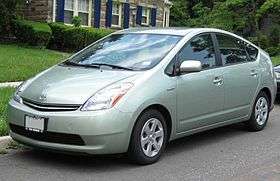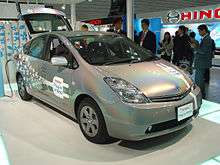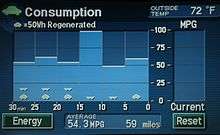Toyota Prius (XW20)
The Toyota Prius is a full series-parallel hybrid electric compact car developed and manufactured by the Toyota Motor Corporation. The second generation Prius had been completely redesigned as a compact fastback. The XW20 series represented the second generation of the Toyota Prius, replacing its XW10 predecessor. The United States Environmental Protection Agency (EPA) and California Air Resources Board (CARB) rated the Prius as among the cleanest vehicles sold in the United States based on smog forming and toxic emissions in 2008.[3] Toyota sold about 1,192,000 of the second generation Prius worldwide.[4]
| Toyota Prius (XW20) | |
|---|---|
 | |
| Overview | |
| Production | 2003–2009 (Japan) 2004–2012 (China) |
| Model years | 2004–2009 (N.America) |
| Assembly | Toyota City, Aichi, Japan (Tsutsumi plant) Kariya, Aichi, Japan (Fujimatsu plant) Changchun, Jilin, China (China market) |
| Designer | Hiroshi Okamoto (2001)[1] |
| Body and chassis | |
| Class | Compact car |
| Body style | 5-door liftback |
| Layout | Front-engine, front-wheel-drive |
| Platform | Toyota MC platform |
| Powertrain | |
| Engine | Toyota Hybrid System II Gasoline: 1.5 L 1NZ-FXE DOHC I4 VVT-i 57 kW (76 hp) @ 5000 rpm 115 N·m (85 lb·ft) @ 4200 rpm Electric: 500 V[2] 50 kW (67 hp) @ 1200 rpm 400 N·m (295 lb·ft) @ 0 rpm AT-PZEV Hybrid system net horsepower: 110 hp (82 kW) |
| Transmission | 1-speed planetary gear |
| Hybrid drivetrain | Power-split Hybrid |
| Dimensions | |
| Wheelbase | 2,700 mm (106.3 in) |
| Length | 4,450 mm (175.2 in) |
| Width | 1,725 mm (67.9 in) |
| Height | 1,490 mm (58.7 in) |
| Curb weight | 1,317 kg (2,903 lb) |
| Chronology | |
| Predecessor | Toyota Prius (XW10) |
| Successor | Toyota Prius (XW30) |
Development
In 1999, Toyota began development on a second generation Prius under chief engineer Shigeyuki Hori. In 2001, Hiroshi Okamoto's exterior design was approved and frozen for production.[1] In 2003, the Prius was completely redesigned as a compact liftback, with redistributed mechanical and interior space significantly increasing rear-seat legroom and luggage room. The 2004 Prius is even more environmentally-friendly than the 1997–2003 model (according to the EPA), and is 6 inches (150 mm) longer than the previous version.[5] Its more aerodynamic Kammback body balances length and wind resistance resulting in a drag coefficient ( Cd) of 0.26.[5] Chief engineer Shigeyuki Hori's development effort led to 530 patents filed for the vehicle.[6]
The Prius uses an all-electric A/C compressor for cooling, an industry first,[7] and also adds an electric power steering system to further minimize engine belt-driven engine accessories. Combined with a smaller and lighter NiMH battery, the XW20 is more powerful and more efficient than the XW11.[8][9] In the U.S., the battery pack of the 2004 Prius is warranted for 100,000 miles (160,000 km) or 8 years.[10] The warranty for hybrid components in California and the seven Northeastern states that have adopted the stricter California emission control standards is 150,000 miles (240,000 km) or 10 years.
Battery
The second generation Toyota Prius makes use of a 201.6-volt NiMH battery composed of 28 modules, where each module is made of six individual 1.2-volt, 6.5 Ah Prismatic NiMH cells. The 7.2-volt modules each contain a charge controller and a relay. The 28 modules are connected in series to produce a total energy storage capacity of 1.310 kWh (via 201.6-volts × 6.5 Ah). The battery control computers keep the state of charge (SOC) between approximately 40 and 80 percent (shallow cycling), where the average SOC hovers around 60 percent, allowing about 400 Wh of useful energy storage to capture energy from regenerative braking and to release it back into the hybrid drive-train through Motor-generator 1 and Motor-generator 2 in the power split device. The shallow cycling enables the hybrid battery to last tens of thousands of cycles, which translates into decades of use and in many cases more than 200,000 miles (320,000 km) of operation. The computer controlled charging and discharging of the battery enhances its cycle life, calendar life, and thermal control performance. Passive battery cooling and heating is accomplished through the metal case of the battery assembly pack, while a forced air cooling system with a blower motor and ducting system enables active cooling of the HV battery.
_liftback_02.jpg)
It is classified as a SULEV (Super Ultra Low Emissions Vehicle) and is certified by California Air Resources Board as an "Advanced Technology Partial Zero Emission Vehicle" (AT-PZEV).[5]
Among the Prius's options are Toyota's implementation of a Smart Key System (the feature can be user-deactivated), DVD navigation on the multi-function display, Vehicle Stability Control and Bluetooth for hands-free calling. A new Intelligent Parking Assist system was available in Japan and Europe since its launch.[11]
From 2005 to 2009, the second generation Prius had been built by FAW-Toyota in the city of Changchun for the Chinese market.[12] It was reported that a total of 2,152 Prius were sold in 2006 and 414 in 2007. The relatively low sales was blamed on high price, about US$15,000 higher than the equivalent in Japan or the U.S., caused by high duties on imported parts.[13] In early March 2008, Toyota cut the price of Prius by up to eight percent or US$3,000 to CN¥259,800 (US$36,500). It was thought that the sales dropped as a result of both a lack of acceptance and increased competition. The Honda Civic Hybrid was exported to China from 2007.[14]
Toyota's design and development efforts paid off during the 2005 European Car of the Year competition where the Prius won ahead of the Citroën C4 and the Ford Focus. The Prius and the Nissan Leaf are the only cars using drivewheel electric motors to have won this competition, where the usual winners are mainstream hatchbacks and sedans/saloons from major European manufacturers.
Research plug-ins

From 2006 to 2009 Toyota tested 126 Prius models in the U.S., Japan and Europe that had the NiMH battery replaced with a lithium-ion battery pack.[15]
In July 2007, Toyota received both Japanese and American governmental approval to begin testing plug-in hybrid models using a modified NiMH battery on public roads.[16] The first plug-in Prius in America went to South Carolina.[17] Researchers at the Advanced Power and Energy Program at the University of California, Irvine, and the Institute of Transportation Studies at the University of California, Berkeley, began testing two specially made Priuses and analyzing driver behavior, study air quality and energy use.[18][19]
Model year changes

_hatchback_(2018-11-02)_02.jpg)
In late 2005 (for the 2006 model year), Toyota introduced some minor cosmetic changes for the XW20, such as a slightly updated front-end, revised instruments, and repositioned rear seats.[20] Other changes comprised a higher-resolution liquid crystal display, as well as new optional features such as a backup camera, advanced air bags and an upgraded audio system with an auxiliary input.
In 2006 (2007 US model year) the Prius added side-curtain air bags (standard on all models). A Touring Edition was introduced, with an elongated and larger rear spoiler as well as larger, sharper-pointed, seven-spoke, 16", magnesium wheels with plastic hubcap covers to protect them from scratches when parking against the curb. The Touring Edition also comes with a firmer, European-style, tuned suspension, standard high-intensity-discharge (HID) headlights, and integrated (non-HID) fog lights.
In 2005, Toyota had to fix a software glitch that caused the Prius' engine to enter "limp" mode with electric-only operation, following 68 stall complaints in the U.S. out of 160,000 worldwide sales.[21][22] In June 2006, Toyota also recalled about 170,000 Prius models from 2004–2006 due to a faulty intermediate shaft and sliding yoke in the power steering system.
Safety
| Euro NCAP test results | ||
|---|---|---|
| Toyota Prius (2004)[23] | ||
| Test | Score | Rating |
| Adult occupant: | 34 | |
| Child occupant: | 43 | |
| Pedestrian: | 13 | |
A 2011 Los Angeles Times article stated that complaints about sudden acceleration and rollover from 2006–2009 models have led to recalls. On another matter, an NHTSA database shows that 49% of all customer complaints about these model years were related to lighting, headlamps or visibility. Out of 216,000 Priuses with the optional high intensity discharge (HID) headlamps, there were 28,000 warranty repairs of this system. The headlamps would sometimes shut off without warning, and in rare cases, both headlamps would shut off. There were some injuries but no fatalities. Toyota avoided a recall on the headlights by agreeing to a class action settlement in which the warranty period was extended from three years to five years and by agreeing to reimburse owners for previous repairs. There was some remaining controversy over whether the failures were caused by the bulbs themselves or the computer system controlling them.[24]
US National Highway Traffic Safety Administration (NHTSA) crash testing of the 2004 US model year Prius yielded a five-star driver and four-star passenger rating in the frontal-collision test (out of five stars). Side crash results were four out of five stars for both front and rear seats. The car scored four out of five stars in rollover testing.[25]
US Insurance Institute for Highway Safety crash tests scored the Prius Good overall in frontal collisions and Good overall in side-impact collisions in models equipped with side airbags.[26] A Poor score was given to models without side airbags.[27] Side curtain and torso airbags became standard on 2007 American models.
Official government fuel consumption data

United States
In the U.S., the Environmental Protection Agency (EPA) test results must be posted on new vehicle windows, and are the only fuel consumption figures that can be advertised. EPA testing procedures for all vehicles were revised in 2007 in an attempt to better match what the average driver would achieve.[28]
The following data is taken from the EPA figures for the Prius: 48 mpg‑US (4.9 L/100 km; 58 mpg‑imp) city driving, 45 mpg‑US (5.2 L/100 km; 54 mpg‑imp) highway driving, 46 mpg‑US (5.1 L/100 km; 55 mpg‑imp) combined.[29]
United Kingdom
The official UK fuel consumption data, provided by the Department for Transport, rates the Prius as: 56.5 mpg‑imp (5.00 L/100 km; 47.0 mpg‑US) urban, 67.3 mpg‑imp (4.20 L/100 km; 56.0 mpg‑US) extra urban and 65.7 mpg‑imp (4.30 L/100 km; 54.7 mpg‑US) combined.[30]
Air pollution
In the United States the EPA measures a vehicle's air-borne pollution based on hydrocarbons, nitrogen oxides, carbon monoxide, particulate matter and formaldehyde before assigning them a score.[31] In most states the XW20 Prius is rated Tier II Bin 3.[32] CARB also does its own emission scoring, the XW20 Prius meets AT-PZEV certification in California and states that adopted CARB emission rules.[33]
The second generation Prius tied with the MINI Cooper D as the fourth least CO
2-emitting vehicles at 104 g/km, behind the Ford Fiesta Econetic at 98 g/km and the tied Volkswagen Polo 1.4 TDI/SEAT Ibiza 1.4 TDI at 99 g/km. It is the least CO
2-emitting gasoline powered car (the Ford and the Polo/Ibiza run on diesel).[34]
Awards
- 2004 Motor Trend Car of the Year.[5]
- 2004 Car and Driver magazine's Ten Best list.
- 2004 North American Car of the Year award.[35]
- 2004 International Engine of the Year 2004.
- 2004 "Best Engineered Vehicle for 2004" by SAE's Automotive Engineering International magazine.[36]
- 2005 European Car of the Year.[37]
- 2006 EnerGuide Award (Midsize).[38]
- 2006 Intellichoice Best Overall Value of the Year, Midsize.[39]
- 2007 Intellichoice "Best in Class Winner": best retained value, lowest fuel, lowest operating costs, lowest ownership costs.[40]
- 2007 Swiss government named Toyota Prius the world's greenest car in a draft study of over 6,000 cars.[41]
- 2008 "Green Engine of the Year" from International Engine of the Year Awards.[42]
- 2008 JD Power and Associates "Most Dependable Compact Car",[43] and again in 2009[44]
- ABC News Top 10 Innovations of the Decade.[45]
References
- "岡本浩志" [Okamoto Hiroshi] (in Japanese). Chiba University. 2006. Retrieved 2016-06-21.
- Kamiya, Munehiro. "Development of Traction Drive Motors for the Toyota Hybrid System" (PDF). Toyota Motor Corporation. Retrieved 2015-09-18.
- "2008 Toyota Prius" (Press release). Hybridcar.com. 2007-10-21. Retrieved 2009-07-14.
- Toyota Europe News (2013-07-03). "Worldwide Prius sales top 3-million mark; Prius family sales at 3.4 million". Green Car Congress. Retrieved 2013-07-03.
- "Motor Trend 2004 Car of the Year Winner: Toyota Prius". Motor Trend. US. 2003-12-01. Retrieved 2007-12-21.
- "Innovators: Shigeyuki Hori". Time. 2004-08-03. Retrieved 2010-01-10.
- Bowden, Robert. "2004 Toyota Prius Review". About. US. Archived from the original on 2004-07-01.
- Olszewski, Mitch (March 2011). "Evaluation of the 2010 Toyota Prius Hybrid Synergy Drive System" (PDF). US: Department of Energy. Retrieved 2019-02-24.
- "Test Drive Notes: 2004 Toyota Prius". Car Talk. US: Dewey, Cheetham and Howe. Archived from the original on 2004-05-19., Car Talk. Retrieved 2007-12-21.
- "Pressroom : Our Point of View / Toyota". Blog.toyota.com. Archived from the original on 2009-03-31. Retrieved 2009-07-14.
- Toyota. "Intelligent Parking Assist – Toyota Europe Corporate Website". Toyota.eu. Archived from the original on 2008-02-25. Retrieved 2009-07-14.
- "Toyota Delays Production of Third Generation Prius in China". ChinaAutoWeb.com.
- Ian Rowley (2007-11-05). "Prius sales yet to catch fire in China". BusinessWeek Eye on Asia blog. Retrieved 2010-06-05.
- "In China, Toyota cuts price of Prius by 8% due to slowing sales". AutoblogGreen. 2008-03-07. Retrieved 2010-04-28.
- Ohnsman, Alan (2009-09-14). "Toyota Remains With Nickel After Lithium Prius Test". Bloomberg.com. Retrieved 2009-09-15.
- Abuelsamid, Sam (2007-07-25). "Toyota gets Japanese approval for PHEV Prius road tests". Autobloggreen.com. Retrieved 2009-07-14.
- Abuelsamid, Sam (2007-07-18). "South Carolina gets first plug-in hybrid". Autobloggreen.com. Retrieved 2009-07-14.
- "Toyota plug-in hybrid hits the road". The Boston Globe. Associated Press. 2007-07-26. Retrieved 2009-12-22.
- "Newsinfo.inquirer.net". Newsinfo.inquirer.net. Archived from the original on 2008-06-11. Retrieved 2010-10-03.
- "Prius' minor makeover". GoAuto. John Mellor. December 16, 2005. Retrieved 2010-11-27.
- NAFTC eNews Toyota Prius Recall Announced – October 2005
- Naftc.wvu.edu
- "Euro NCAP results for Toyota Prius". euroncap.com. 2004.
- Bensinger, Ken (2011-01-19). "Toyota to settle lawsuit over Prius headlights that shut off without warning". Los Angeles Times. Retrieved 2017-07-29.
- "2004 Toyota Prius 4-DR". Archived from the original on 2009-05-24.
- "IIHS-HLDI: Toyota Prius 2007–09 models". Iihs.org. 2008-09-25. Retrieved 2010-10-03.
- "IIHS-HLDI: Toyota Prius 2004–06 models". Iihs.org. 2006-10-06. Retrieved 2010-10-03.
- Gartner, John (2007-05-14). "Hybrid Cars' Fantasy Mileage Ratings Drive Into the Sunset". Wired. CondéNet. Retrieved 2008-06-03.
- "2008 Toyota Prius". U.S. EPA. Retrieved 2007-12-25.
- "Vehicle details for Prius 1.5 VVT-i Hybrid E-CVT". UK Department for Transport. Retrieved 2008-09-02.
- "Getting a Better Understanding of Vehicle Emissions Standards". Hybrid Cars. 2006-03-31. Retrieved 2009-07-14.
- "the greenest vehicles of 2008". greenercars.org. Archived from the original on 2007-09-10. Retrieved 2009-07-14.
- "Frequently Asked Questions on Toyota Prius Hybrid". Cleangreencar.co.nz. Archived from the original on February 25, 2008. Retrieved 2009-07-14.
- "Best on CO
2 rankings". UK Department for Transport. Archived from the original on 2008-03-12. Retrieved 2008-05-30. - "2003-04 North American Car of the Year". Toyota.
- "'Best Engineered Vehicle for 2004'".
- "Toyota Prius wins 2005 European Car of the Year". Europe: Toyota. Archived from the original on 2014-05-12.
- "2007 EnerGuide Awards". Archived from the original on 2009-04-17.
- "2006 Toyota Prius".
- "2007 Toyota Prius".
- "Switzerland, renowned for its clean Alpine air and pristine ski slopes, has named Toyota's Prius the world's greenest car". Reuters. 2007-07-27. Retrieved 2010-11-30.
- "Green engine of the year 2008". International engine of the year awards. UKIP Media & Events. 2008-06-30. Archived from the original on 2013-01-05. Retrieved 2008-06-30.
- "2008 Vehicle Dependability Study (VDS)". J. D. Power. Retrieved 2009-05-19.
- "Dependability ratings by category". J. D. Power. Retrieved 2009-05-19.
- "The Top 10 Innovations of the Decade – ABC News". Abcnews.go.com. 2000-05-02. Retrieved 2009-12-22.